MAJOR FESTIVALS AND EVENTS
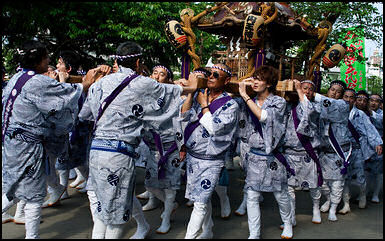
Every town, city and village either has a unique festival or a unique version of a national festival. The ones included here are the most well known ones.
Many Japanese festivals are called "matsuri. — “Matsuri”, a Japanese word that means “to entertain” and “to attend to,” is used to describe both festivals and worship at Shinto shrines. It also implies respect duty, and willingness to listen to and serve “kami” (“spirits or gods”) and brings their power to everyday life. Most matsuri give honor and thanks to the kami associated with the shrines used in the festivals.
Matsuri are usually religious occasions that allow parishioners of a local shrine to commune with the god of that shrine and wish for a plentiful harvest. They usually feature purification rites, offerings, sharing of food, rituals carried out by priests and a procession of “mikoshi” — portable shrines carried by parishioners of the shrine — and decorated floats whose aim is to bring the attention of the gods to the needs of the people.
Japan has 14 national holidays, more than most countries, and these are welcome relief for salarymen who work on Saturdays and have trouble using their vacation leave. The passage of the "Happy Monday" law in 1998, placed most of the nations holidays on Monday. Skits, dances and battle reenactments by men in samurai costumes have become popular in recent years. Staged at places like Nagoya castle, the shows feature famous figures from the Sengoku warring Staes period (1493-1573) such as Oda Nobunaga, Toyotami Hideyoshi and Tokugawa Ieyasu. Some events feature discussions and chances to meet-and-greet “warlords.” There are also services that rent out warlords for weddings.Book: “Great Festivals of Japan” by Hiroyuki Ozawa (Kodansha International, 2000). Websites: JNTO Calendar of Events JNTO Calendar of Events ; JNTO Festivals List JNTO Festivals List ; Japan Visitor Japan Visitor
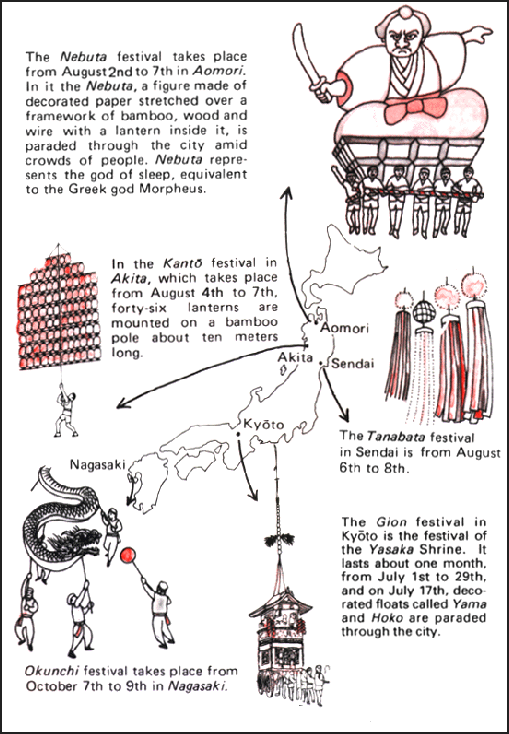
big summer festivals of northern Japan
Tourist Office: Tourist Office, Japan, tel. 81- , fax: Websites: Map: Japan National Tourism Organization JNTO Hotel Web Site: Japan Hotel Web Sites: JapanHotel.net JapanHotel.net Ryokan and Minshuku Japanese Guesthouses Japanese Guesthouses Budget Accommodation: Japan Youth Hostels (click hostels for good map and description of hostels) Japan Youth Hostels Check Lonely Planet books; Getting There: is accessible by air and by bus and by train from Tokyo (six hours) and Osaka (12 hours) and other Japanese cities. Lonely Planet Lonely Planet
JULY

Hakata doll July 1st-15th — “Hakata Dontaku Festival” in Fukuoka. A fleet of Yamagasa floats with elaborate decorations representing castles, halls and dolls are pulled or shouldered by men dressed in bright traditional costumes.
July — “Ama Matsuri” is a women's diving festival held in Shirashima
Early July — “Fourth Sumo Tournament in Nagoya “
Early July — “Russian Culture Festival “ in Hakodate on Hokkaido Island is a festival of Russian culture held since 2006. In 2011 the event featured a performance by the State Circus troupe, a concert of the Pyatnitsky Choir and an exhibition of unique old Japan photos collected by Russians. More than 1 million Japanese attend it. Hakodate, the site of the opening, has long played a significant role in the development of Russian-Japanese relations.
July 7th — “Tanabata Festival” is celebrated nationwide with people writing their wishes on strips of colored paper or origami, which they attach to branches of bamboo trees or float down rivers and streams. According to Chinese folk tales this is one day that the separated lovers, Altair and Vega, can meet across the Milky Way.
Sendai's Tanabata festival is probably the most famous but it is held on August 7th. In Tokyo, the Shitamachi Tanabata Festival is held from July 7th to 13th near Ueno Station on Kappabashi Hondori street. A 1.2 kilometer section if road is illuminated with bamboo ornaments representing the Milky Way. There are a number of events including dancing, drumming, marching bands and a flea market.
July 7th — “Heron Dancing” at Kyoto's Yasaka Shrine.
July 13th-15th — “Bon Festival” traditionally takes place around July 15 on the lunar calendar, when the souls of the dead are believed to return to their homes. Many people visit the graves of the ancestors and set up lanterns to guide the spirits of ancestral souls to and from their homes. Offerings of food are made to the deceased and sometimes special “bon odori” dances are performed at shrines and schools and lanterns are floated down rivers. Neighbors gather throughout Japan to dance at this time. In most places this festival is held around August 15.
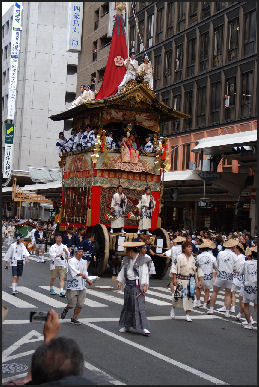
July 17th — “Gion Matsuri” in Kyoto is one of Japan's most famous festivals. First held in A.D. 869, it features a procession of 32 yamaboko floats supported on large wooden wagon wheels and pulled by teams of men, with musicians playing traditional Gion-bayashi music. The largest floats are the size of houses and are pulled by teams of 70 men. Some carry a complete a gong and flute orchestra and have a 60-foot-high halberd-shaped masts. The Gion festival has reportedly only not been held twice in its 1,100 years run (during the Onin War (1467-1477) and in 1943 during World War II)
Traffic is banned from the main streets in downtown Kyoto and people show up hours in advance to lay claim to prime viewing spots along Shijo Avenue where the procession takes place. The floats are decorated with tapestries from as far away as the Middle East and Europe, a holdover from when the festival was an opportunity for merchants to display their wealth. One tapestry was produced in Brussels in the 16th century. The floats continue to be constructed using traditional methods. Ropes band the timbers rather than nails.
The festival officially begins when a “chigo” — a sacred six-year-old to eight-year-old boy — lifts a sword, with the help of a man sitting behind him, and cuts a ribbon suspended over the street with a single stroke. The chigo engages in several Shinto rituals to become a “messenger of God” during the festival. Before the event the chigo’s face is painted white and the following prayer is said: “I hope that God will enter the sacred child’s heart from the top of the float, rising to the heavens.” Rich Kyotoites pay $100,000 or more for the privilege of having their son cut the ribbon. By tradition all those connected with the float carrying the chigo are male.
The floats are sponsored by clubs that are similar to the schools that sponsor floats at Carnival or Mardi Gras. Three days before the festival shops and houses along the parade route open their doors and display family treasures such as folding screens, sculptures and kimonos. In some cases traditional dancers are visible behind lattice windows. The best place to see the screens are along Muromachi and Shinmachi Streets, which are lined with textile merchants. About 180,000 people showed up for the Gion Matsuri in 2008.
Mid July — “Mitama Matsuri” at Yasukuni Shrine in Tokyo features a mikoshi float parade, bon odori dancers and the lighting of thousands of lanterns.
Mid July — “Gion Daiko Festival” in Fukuoka features a parade of floats, moving to dynamic rhythm of drums.
July 20th-27th — “Sagi-Mai Festival” in the small town of Tsuwano in the Shimane Prefecture draws spectators from all over Japan to watch the unique 'Heron Dance.'
July 24th-25th — “Tenjin Matsuri” is a festival held at the Temmangu Shrine in Osaka that features fireworks and a parade of floating shrines on the Dojima river. July — “Samurai Warrior Festival” in Minami-Soma, Fukushima Prefecture features about 500 participants in samurai costumes who parade on horseback on a three kilometers course. After a one-kilometer horse race riders fight for sacred clothes launched into the air in a ritual which is said to date back 1,100 years.
Second to Last Saturday in July — “Yokohama Port Festival” features a fireworks display in which 7,000 fireworks are set off from the sea in front of Yamashita Park in Yokohama. The display lasts from 7:00pm to 8:40pm.
Last Saturday in July — “Sumidagawa Hanabi Taikai” is the largest fireworks display in Tokyo. Held over the Sumida River in Asakusa, the festival traces its origins back to a festival held to placate river gods after the great famine of 1732, in which nearly 1 million people starved to death. Most of the fireworks explode about 200 meters in the air and produce circular star bursts about 150 meters across.
About 10,000 fireworks are launched from one site near Asakusa Station between 7:30 and 8:30pm. Another 10,000 or so fireworks are launched from another site about a kilometer away near Sakurabashi bridge near Sensoji Temple between 7:10 and 8:30pm. Many Japanese don bathrobe-like yukatas to watch the fireworks.
Last Saturday in July — “Fireworks Festival” in Urayasu in Chiba Prefectures features 8,500 fireworks produced by the
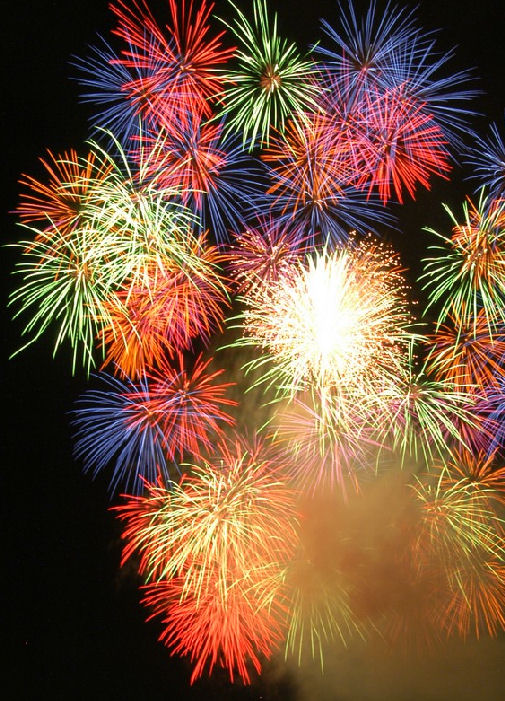
prestigious fireworks manufacturer Kagiya. The display lasts from 7:00pm to 8:45pm.
Last Weekend in July — “Fireworks Festival” in Tochigi near Tokyo features 20,000 fireworks set off over the Omoigawa River in Oyama. The display lasts from 7:00pm to 9:00pm.
Last Weekend in July — “Fireworks Display” in Oita in Kyushu features 6,000 fireworks set off over Beppu Bay. The display lasts from 8:10pm to 9:10pm.
Late July — “Abegawa Fireworks Festival” in Shizuoka features 15,000 fireworks and lasts from 7:00pm to 9:00pm.
Late July — “Toyoda Oiden Matsuri Fireworks Festival” in Okazaki, Aichi Prefecture features 15,000 fireworks and lasts from to 9:00pm.
Late July — “Sogadon-no-Kasayaki Festival” in Kagoshima features the burning or hundreds, sometimes thousands, of disused umbrellas on a dry river bed.
Late July — “Heso Matsuri” in Shibukawa, Gunma Prefecture features belly dances by dancers who have faces drawn around their navels.
Late July — “Torchlight Noh” is held at Nishi no Maru Park near Osaka Castle.
Late July or Early August — “Fuji Rock Festival” at the Naeba Ski resort in Niigata is a huge multi-day Japanese Woodstock that attract around 60,000 people and top name acts from Japan and around the world. It was originally held at the foot of Mt. Fuji, hence the name.
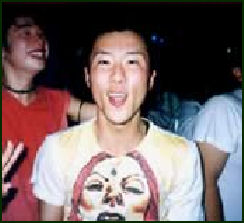
festival goerOasis, Run DMC, Foo Fighters, the Chemical Brothers, Gomez, Primal Scream, Patti Smith, Tricky, Orbital, Echo and the Bunnymen, Ani DiFranco, Eminem, Brian Eno, Red Hot Chil Peppers, Neil Young, Prodigy, White Stripes, Black Rebel Motorcycle Gang, Elvis Costello, Underworld, Bjork, and Iggy Pop are among the artists that have performed.
The first Fuji Festival was in 1997 and was shortened due to a typhoon. Artists featured in 2007 included The Cure, Muse, Kings of Leon, Jarvis Cocker, Beastie Boys, Iggy and the Stooges, the Chemical Brothers, and Yo la Tengo. Artists featured in 2008 including Underworld, Grandmaster Flash, Bloc Party, Feeder, Primal Scream, Bootsy Collins, Travis and Tricky. One day passes that year were ¥16,800. Three days were ¥39,800.
Late July until Mid September — “Echigo-Tsumari Art Triennial” has been called the “world’s biggest outdoor art exhibition.” Last held in 2006 in Niigata, it featured works by 300 artists from 40 countries — including Yayoi Kusama, James Turrell, Ernesto Neto, Richard Deacon and the Finnish conceptual artist Maaria Mirkkala — using 760 square kilometers of the Japanese countryside as a gallery.
Late July — “Soma Nomaoi Festival” in Haramachi, Fukushima Prefecture has been designated a national intangible cultural heritage. It lasts for three days and climaxes when 500 men is samurai armor and waving banners engage in a battle to capture colorful sacred flags fired into the air with fireworks. . Before the battle sword-carrying, armored samurai on horseback parade around and loudly shout their names, The festival is said to have been launched than 1,000 years old by the legendary rebel leader Taira no Masakado as a training exercise for war.
July 31st-August 1st — “Gojinjo-daiko Nabune Festival” is a festival held in Wajima, Ishikawa Prefecture that features a performance of the famous 'Gojinjo' drums played by drummers wearing grotesque masks and seaweed wigs.
AUGUST
Early August — “Summer Sonic” is a music festival held at stadiums and arenas in Osaka and the Tokyo area. Performers have included Radiohead, Blur, Blondie, Offspring, No Doubt, Morrissey, Siouxsie and the Banshees, the Arctic Monkeys, Tool, Linkin Park, Massive Attack, Cocteau Twins, My Chemical Romance, The Doors, Marilyn Manson, James Brown, Travis, and Devo.
Early August — “Fireworks Festival” in Nagaragawa, Gifu is Japan’s largest fireworks display, with over 30,000 fireworks. The display lasts from 7:30pm to 8:45pm.
Early August—“Nagoaka Matsuri Fireworks Festival” in Nagaoka, Niigata Prefecture features over 20,000 fireworks. The display lasts from 7:25pm to 9:10pm.
Early August—“Shimmei Fireworks Festival” in Ichikawamisato-cho, Yamanashi Prefecture features over 20,000 fireworks and lasts from 7:20pm to 9:00pm.

Early August — “Fireworks Display” in Tokyo at Shinozaki Park features over 14,000 fireworks set off over the Ichikawa River. The display lasts from 7:15pm to 8:30pm.
Early August — “Fireworks Display” in Atsugi near Tokyo in Kanagawa Prefecture features over 10,000 fireworks, including a 250-meter-long finale set off over the Sagamigawa River. The display lasts from 7:00pm to 9:00pm.
Early August — “Fireworks Display “ in Yamagata features over 12,000 fireworks shot off over the Mogamigwa River in Sakata and lasting from 7:30pm to 9:00pm.
Early August — “Fireworks Display” in Fukuoka on Kyushu features over 13,000 fireworks set off over Chikugogawa river in Kurume. The display lasts from 7:40pm to 9:40pm.
Early August — “Hakodate Port Festival” in Hakodate, Hokkaido features a fireworks display with over 8,000 fireworks. The display lasts from 7:45pm to 9:00pm.
Early August — “Fireworks Festival” in Osaka on the banks of the Yodogawa River between Shinmido-Yodogawa Station and JR Tsukamoto Tekkyo railway bridges. The display lasts from 8:00pm to 9:00pm.
Early August — “Hanagasa Matsuri” in Yamagata features a parade of dancers wearing flower-decorated hats.
Early August — “Gyoja Matsuri Dorogawa” features hundreds of young men in demon masks doing a demon dance.
Early August — “Wasshoi Hyakuman Natsu Matsuri” in Kita-Kyushu near Fukuoka in Kyushu boasts a great dance with 10,000 dancers.
Early August — “Yagibushi Matsuri” in Kiryu, Gunma Prefecture features “yagibushi folk songs.”
August — “Obon” (Festival of the Dead) is when the souls of the dead are believed to return to their homes. Many people visit the graves of the ancestors and set up lanterns to guide the spirits of ancestral souls to and from their homes. Many Japanese seem to feel that more people die in August than any other time of the year. Sometimes there are tie-ins with events that remember the dead from the bombings of Hiroshima and Nagasaki and the ed of World War II which also occurred in August.
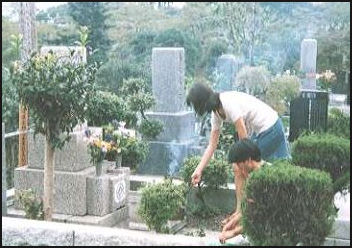
Bon is celebrated nationwide over the course of a week with feasting, the sprucing up of graves and prayers for the dead. Offerings of food are made to the deceased and sometimes special “bon odori” dances are performed at shrines and schools and lanterns are floated down rivers. Neighbors gather to dance informal bon odori dances. Taiko drums are often heard in the distance.
Obon is a time when urban families return to the hometowns to honor their ancestors. Many company employees are given a week off work along with a summer bonus. Roads are jammed with cars. Trains and planes are packed with people. For children it is happy time when they get to go to their grandparent’s house and play outside in the countryside. For traveling adults it is often a stressful time when they do their best to keep a game face in front of their parents or in-laws.
The Japanese believe that during obon the dead return to earth and roam among the living. As bon approaches you find small bundles of straw for sale at flower shops and supermarkets. On the first day of Bon, the dead are said to find their way back their families by the light of burning straw (“mukaebi” , or “welcoming fire”). On the last day, straw is burned again (“okuribi” or “send-off fire”) for the dead to return to the land of the dead. In some places red lanterns are left out to guide ghosts to their old homes and help them return to the spirit world.
In Hibiya Park in Chiyoda Ward in Tokyo, women in yukata dance to the popular Bon Oduri song “Marunouchiondi”. Around 16,000 people show up for the event.
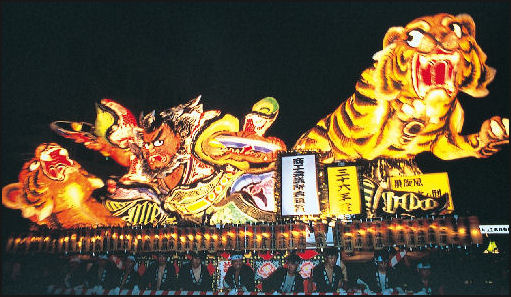
nebuta
August 2nd-7th — “Nebuta Matsuri” is one of the three great summer festivals of northern Japan. In the towns of Aomori and Hirosaki huge lit-up, paper-mache figures (“nebuta”) are pulled on floats through the streets at night. The celebration is believed to have inspired by the ritual of floating paper lanterns down rivers during the Tanabata Festival on July 7th.
The Nebuta festival has traditionally been held on the seventh day of the seventh lunar month. It is rooted in a fairy tale about a young cowherd who falls in love with a beautiful weaver girl who is also the youngest daughter of the Empress of Heaven. The cowherd and the weaver girl secretly marry. When the angry Empress finds out she draws a line between them that becomes the Milky Way. The only time they can get together is on the seventh day of the seventh lunar month.
The huge floats carry the images if historical figures and mythological creatures. The largest ones are nine meters wide, seven meters long and five meters tall and weigh four tons. They are made on wheeled chassis and take local artisans around three months to complete
Nebuta festival lasts for six days. Box seats set up on the side walks cost $25. About 20 floats, illuminated from the inside, are paraded each day of the festival along the 2.3-kilometer parade route. They are maneuvered by teams operating poles attached to the sides of the floats and directed by “sensumochi” (fan wavers). Each float is followed by a troupe of dancers made up of local people and tourists. Clad in cotton kimonos and floral headgear, they dance and revel to traditional music made by drummers, pipers and cymbal players. The festival ends with a fireworks display at Aomori Port and the carrying of floats into the water, with particular attention given to the top three prizewinners. For information check the festival Website: Nebuta
August 4th — “Lantern Festival” at Kasuga Taisha Shrine in Nara features the lighting of 3000 stone lanterns and hanging bronze lanterns at the shrine, producing a wonderful glowing atmosphere.
August 5th — “Torii Matsuri” on Lake Ashi is highlighted by the burning of a huge wooden shrine on the water and floating 100 lighted lanterns on the lake. Lantern floating festivals are held all over Japan around this time. One called Bentenshu Toro-nagashi is held on the Yoshino River in Nara.
August 5th-7th — “Kanto Matsuri” (Pole of Lanterns Festival) in Akita City is another one of the three great summer festivals of northern Japan. The highlight of this event are the twelve-meter-long bamboo poles holding 40 to 50 candle-lit paper lanterns and weighing to 50 kilograms carried by individuals who do fancy steps as they balance the lanterns on their foreheads, shoulders, chins and hips.
The bamboo poles (“kantos”) are quite large and heavy and the lanterns are hung from horizontal bars attached to the central pole. Each one is carried by a single person down an 800-meter-long parade route. The festival is comprised of an evening procession and a daytime parade to choose the best kanto. The kantos are urged forward with the chants of onlookers and the rhythm of taiko drums. In 2005, 70 organizations took turns balancing 235 poles with 10,000 lanterns. More than 1.3 million people came to watch. In 2009 there were about 10,000 paper lanterns hung from 253 poles and carried by teams of men, who perform acrobatic stunts and place the poles on their lower backs and heads.
The origin of the festival is not known. Designed to bring good harvests, it has been held for at least 250 years and most likely evolved from efforts by local farmers to exorcize "sleeping demons" believed to bring disease and misfortune. The festival began taking its present shape in the early 19th century when candles became more widely available. For information check the festival Website: Kantou
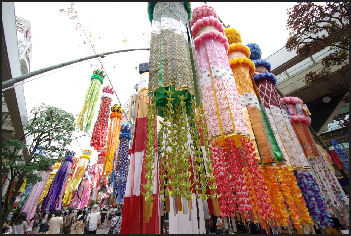
August 6th-8th — “Tanabata Star Festival” in Sendai is the last of the three great summer festivals of northern Japan. It features street decorations of bamboo poles with streamers, banners, ribbons and flowers of almost every imaginable color — all made with washi paper. It is considered the most beautiful of all the Tanabata festivals, which are held in most places in Japan on July 7th.
The colorful bamboo poles are raised for about two miles on two streets in Sendai's main shopping district. The main event is an evening parade in which 2,000 people in 40 groups carry portable shrines through the streets where bamboo poles are displayed. The festival ends with a fireworks display in which about 12,000 fireworks are set off. Sometimes as many as 2 million people show up ofr the event. For information check the festival Website: Sendai City
Second Week of August — “Akagawa Fireworks Festival” in Tsuruoaka, Yamagata Prefecture features over 13,000 fireworks and lasts from 7:15pm to 9:00pm.
Second Week of August — “Fukori Enshu no Hamabi in Fukuroi” , Shizuoka Prefecture features over 30,000 fireworks and lasts from 7:00 pm to 9:00pm.
Second Weekend in August — “Fireworks Festival” in Otsu on Lake Biwa near Kyoto features over 10,000 fireworks set off over the world’s largest fountain. The display lasts from 7:30pm to 8:45pm.

Second Weekend in August — “Fireworks Festival” in Otagawa, Hiroshima features over 18,000 fireworks set off above the Otogawa River. The display lasts from 7:50pm to 8:50pm.
Second Weekend in August — “Fireworks Display Festival” over Tokyo Bay features over 13,000 fireworks set off around Rainbow Bridge. The display lasts from 7:00pm to 8:20pm.
Second Week in August — “Fireworks Display” at Jingu Ballpark No. 2 in Shinjuku Ward in Tokyo features 10,000 fireworks, music and a laser show. The display lasts from 7:15pm to 8:30pm.
Second Week in August — “Fireworks Festival” in Saitama near Tokyo features over 28,000 fireworks set off above the Arakawa River at two different places. The display lasts from 7:00pm to 9:00pm.
Second Week in August — “Fireworks Festival” in Shizuoka near Tokyo features over 13,000 fireworks set off from six spots at Ito beach on the Izu peninsula. The display lasts from 8:00pm to 9:00pm.
Second Week in August — “Fireworks Display” at Kamakura in Kanagawa Prefecture near Tokyo features 3,000 fireworks set off from boats. The display lasts from 7:00pm to 8:15pm and includes fireworks that are set off underwater to create a spectacular sea spray.
August 9th — “Tezutsu Hanabi” is a hand-held fireworks made from bamboo that send flames and sparks fifteen feet into the air. They are set off and demonstrated near Yayoi-bashi Bridge on the Miyagawa river near Takayama.
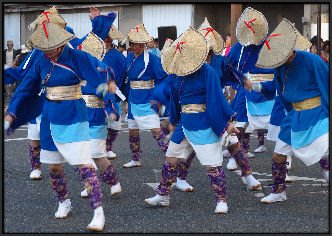
August 12th-15th — “Awa Odori” is a dance festival in Tokushima in which it seems like the whole town takes part. Women in geta sandals and basketlike hats dance in an amusing, charming way. Regarded as Japan’s largest dance festival, it boasts over 100,000 dancers.
Mid August — “Summer Sonic Festival” at Chiba Marine Stadium in Messe Chiba and Maishima in Osaka featured Gwen Stefan, Avril Lavigne, Black Eyes Peas, Cyndi Lauper, The Stranglers, Motorhead, Arctic Monkeys, Kasabian, Manic Street Preachers, Dinosaur Jr., and Bloc Party in 2007. Artists featured in 2008 included the Verve, Prodigy, Sex Pistols, Coldplay, Alicia Keys, Jesus and The Mary Chain. Paul Weller, Devo, and Fatboy Slim. One day tickets are ¥15,000; two day ones are ¥24,000.
Mid August — “Yosakoi Odori” in Kochi showcases a regional dance performed by dancers with wooden clappers.
Mid August — “Suwako Matsuri Fireworks Festival” at Suwa, Nagano is one of the largest of its kind in Japan. It features 41,000 fireworks set off over Lake Suwa. The display lasts from 7:00pm to 9:00pm.
Mid August — “Kammon Kaikyo Fireworks Festival” at Shimonoseki, Yamaguchi Prefecture features 13,000 fireworks. The display lasts from 7:50pm to 8:40 pm.
August 15th-16th — “Yamaga Toro Festival” in Yamaga in Kumamoto Prefecture is highlighted by a folk dance parade of 1000 women each with a gala lantern.
Mid August — “Shansham Matsuri in Tottori” is highlighted by a folk dance parade with 4,000 dancers with jingling bells attached to umbrellas.
Mid or Late August — “Eisa Festival” is an island wide festival in Okinawa that features young men and women in traditional costumes performing a bon dance to the musical accompaniment of samisen and drums. It honor ancestors.
August 16th — “Daimon-ji Yaki” in Kyoto features enormous bonfires lit on five mountains in the form of five Chinese characters and shapes. The Chinese character for “dai” (“large”) measures 230 by 510 feet. The other characters are “myo” and “ho” , which together form “the marvelous law of Buddha “torii” (a Shinto gate) and “funagata” (the shape of a ship). The fires are lit at 8:00pm and the best place to see them is from the banks of the Kamogawa River. The rite is performed to pay respects to the souls if ancestors and guide them their trip back to the other world. . The origins of the rite is unknown. It may date back to A.D. 815 when a monk started a bonfire to dispel the plague.
Mid August 16th — “Daimon-ji Yaki” in Kaenemachi in Kanagawa Prefecture near Tokyo features enormous bonfires lit in the form of Chinese characters and a fireworks display with 3,000 fireworks.

Kodo Late August — “Fireworks Competition” in Omagari in Akita Prefecture features 15,000 fireworks an competitions in three categories including daylight fireworks. The display lasts from 5:00pm and 5:45pm and 6:50pm to 9:40pm.
Late August — “Fireworks Display” in Toyokawa in Aichi Prefecture near Nagoya features 2,000 fireworks, including 600 traditional hand-held “tezutsu fireworks.” The display lasts from 7:00pm to 9:50pm.
Late August — “Earth Celebration” on Sado Island is a musical event for musicians from all over the world hosted by the taiko drum group Kodo. Guest in the past have included Korean dance groups, jazz musicians, Trinidad steel drum units and Balinese bamboo xylophone groups. The vent draws several thousand people. It was held for the 21st time in 2008. The line up in 2007 included an Indian tabla player, a Puerto Rican conga drummer, a tap dancer and avant-garde Japanese artists.
Late August — “Japansplash Reggae Music Festival” in Tokyo features both international and domestic groups that produce Jamaican sounds. There are not so many big names from Jamaica at the event.
Late August — “Akakusa Samba Carnival” in Taito ward in Tokyo attracts around 500,000 people with music, dancing and drumming. It features a competition and shows with dancers from Brazil.
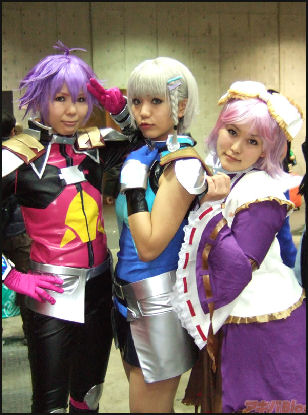
Comic Mart Late August — “Comic Mart” in Tokyo last for two days and is one of the biggest events of any kind in Japan, drawing more than 200,000 manga fans. The fans are a bit like Trekkies at a Star Trek convention. Most stuff their bags with freebies and works by their favorite artists. Some people, known as cosplayers, dress up and act like their favorite characters. Others try to sell their work. There are lectures and auctions of memorabilia and contest for new artists. The event has come a long way since it was first held in 1975 and drew only 700 people. The primary job of the police and guards is to screen out mangas that too sexually explicit.
Late August, Early September — “Saito Kinen Festival” in Matsumoto is a classical and opera music festival with renowned Seiju Ozawa serving as its director. It has performances of popular pieces as well as experimental ones.
SEPTEMBER
September — “Hadaka Festival” is a famous 'naked festival' featuring half-naked men carrying a shrine into the ocean.
September — “Tokyo Game Show” is Japan’s largest gaming event.
September — “Hojoe Festival” in Fukuoka features people who spins top on Japanese fans and cotton threads and even the edge of Japanese swords.
September 1st-11th — “Kaku-No-Ichi” in Oita is festival that features a traditional procession of a feudal lord and his retainers.
Second Week of September — “Katakai Matsuri” at Katakaimachi, Niigata Prefecture features 15,000 fireworks. The display lasts form 7:30pm to 10:20pm.
September 14th and 15th — “Danjiri Matsuri” is the wildest festival in Osaka. It feature teams pulling huge festival floats, weighing up to 4 tons, with ropes through the streets with a couple of nasty turns that sometimes send men standing on the mikoshi flying off or causes the mikoshi to careen out of control. Sometimes the teams consist of more than 100 people. In the past people have been killed.
September 15th — “Respect for the Aged Day” is celebrated throughout the nation.
September 16th — “Yabusame” is a horseback archery demonstration held at Tsurgaoka Shrine in Kamakura. The archers dressed in traditional costumes with funny looking feathered hats attempt to hit targets while riding at full gallop.
September 23rd — “First Day of Autumn” is often celebrated with visit to the ancestral graves to pay respected to deceased relatives.

September 23rd — “Dosjin Festival” is phallus festival held the Utsukushigahara Onsen in Matsumoto. It is named after a pair of deities called 'dosojin' that can be found on stone statues in this region. During the festival women dress up in costumes of giant penises and walk through the streets while wild merry making goes on.
Late September — “Asian Music Festival” in Tokyo.
Autumn — “Shrine Carrying Festival” are held throughout Japan in the autumn. Describing one such event, a travel writer wrote: "The shrine teetered at the top of the steep staircase as its porters struggled with fear and the very real possibility that it could crash and slide out of control down the steps and into the fire. Suddenly the mikoshi careered downwards, for a few seconds apparently out of control, but was soon brought to a halt by the struggling heaving porters."
Autumn Every Three Years — “Yokohama Triennial” is Japan’s largest contemporary arts festival. It was held in the autumn of 2008. It is famous for unveiling of experiential pieces by experimental artists. Some say it tries very hard to be a forum for cutting edge pieces but fails with many pieces simply coming across as puzzling and indefinable. Most of the exhibits are in the port area of Yokohama.
September — “Edo Tenka Matsuri” is held biannually (it was held in 2007) and features a parade of 23 impressive mikoshi portable shrines around Hibiya park. In the Edo period Tenka Matsuri was the only time that ordinary people could enter Edo castle.
OCTOBER
October — “Chrysanthemum Season” is in autumn. Good chrysanthemums viewing areas in Tokyo include the Imperial Palace grounds, Yasukina Shrine, Meiji Shrine Park.
Sundays and Holidays in October — “Deer Antler Cutting” in Nara Park is a Japanese version of a round up and rodeo. The deer are first chased into the Kasunga Taisha Shrine area and corralled off and then wrestled to the ground so their antlers can be sawn off.
October 3rd — “Culture Day” is a national holiday held on the birthday of the Emperor Meiji
October 3rd-4th — “Asama Onsen Taimatsu Festival” , also as the Asama Fire Festival, features a spectacular parade of men carrying burning straw torches. The torches are up to 10 feet high. Drums accompanies the parade.
Early October — “Tsuchiura All-Japan Fireworks Competition” in Tsuchiuru in Ibaraki Prefecture near Tokyo features competitions between numerous fireworks manufacturers. More than 20,000 fireworks are ste off. The display lasts from 6:00pm to 8:30pm.

Early October — “CEATAC” at the Makuhari Messe convention center in Tokyo is Asia’s largest electronics show and a great place to see cutting edge technology. In 2008 a total of 804 companies and groups, of which 289 were from overseas, displayed cool stuff and gadgets in 3,121 booths during the five-day event. Among the highlights were robots that rode on unicycles and bicycles, organic, light-emitting televisions as thin as a map, 3-D full-definition home theater systems and the latest WiMax next generation high-speed technology.
October 7th-9th — “Okunchi Festival” is Chinese in origin is held at the Suwa Shrine in Nagoya. It features a dragon dance, palanquins of various shapes and floats with umbrella shaped decorations.
October 9th-10th — “Takayama Matsuri” at Hachimangu Shrine in Takayama is noted for its parade of colorful floats.
October 11th-13th — “Oeshiki” at Hommonji Temple in Tokyo remembers the Buddhist leader, Nichiren.
October 14th — “Kenka Festival” at Himeji City near Kobe features battles in which men carrying shrines slam their shrines into each other and battle one another, while pom-pom carrying, and stick pounding supporters egg them on, in effort to be the first to climb the Amatsubar Shrine.
Mid October — “Nagoya City Festival” features a very long parade that centers on impersonations of historical figures of Japan.
Mid October — “Izumo Taisha” in Matsue is said to attract deities from all over Japan.
Mid-October — “Country Gold Festival” at the foot of Mount Aso in Kumamoto is a country music festival that draws around 25,000 Japanese county music fans, some of them dressed in cowboy hats and cowgirl dresses doing the two step. Among the Nashville acts that have performed at the festival are Dwight Yokum, Emmylou Harris, Ricky Skaggs, the Charlie Daniels Band and Bill Monroe.
October 15th — “Health Sports Day” is celebrated throughout the nation.
October 14th and 15th — “Nada Fighting Festival” is held at the Matsubara Shrine in Himeji. One of most spectacular festivals in Japan, it features a procession of yatai floats and a battle of mikoshi shrines. It draws around 200,000 people.
The festival season begins around October 1st when local districts allow the public to enter their warehouses and check out their floats. On October 14 the floats are pulled through the streets during the procession. The shrines weigh about two tons each and are garishly decorated. They are pulled by about 100 men to the accompaniment of drumming. Each time the shrines pass within inches of another there is big roar from the crowd.
On October 15, three mikoshi shrines battle it out in an attempt to usher in a bountiful harvest. Each mikoshi represents a local deity and is held up by 45 men. The greater the damage sustained by the shrines during the fight, the happier the deities are and the more likely they are to bring a good harvest.
The festival dates back to 1471 when a local ruler donated 200 bags of rice to help rebuild a shrine which had been burned down in a battle. Floats were used to carry the rice to the top of a local sacred mountain. In the late 16th century the shrine was destroyed again, this time by Toyotomi Hideyoshi as an act of revenge against local people for supporting a rival warlord.
October 17th — “Autumn Festival” at Toshogu Shrine features troops dressed in full samurai regalia are paraded around at this festival in Nikko.
October 22nd — “Jidai Matsuri” , the Festival of the Ages, at Heian Shrine was held for the 114th time in 2008. Representing the epochs in Kyoto's long history from the 8th to the 19th centuries, it and features 2,000 people in period costumes from various periods of Japanese history.
October 22nd — “Fire Festival of Kurama” is celebrated with a long procession of people carry lighted torches to the gates of Yuki Shrine in Sakyo-ku Kyoto. Celebrating the power of fire, this popular festival attracts huge crowds who come to watch sake-inspired, tattooed men run half-naked throughout the streets with burning piles of fire supported on their shoulders. A huge shrine is also carried around the town to the sound of thundering drumbeats.
October 22nd-24th — “Ton-ten-Ton” is a festival in Imari City featuring a parade of palanquins and floats carried by young men a 'happi-coat' uniform with cloths twisted around their head. At high tide on the last evening of this festival the men start jostling with each other in a fierce battle.

Late October and Early November — “Shosoin Display” is a display of selected objects from the priceless Shoso-in collection of art objects at Nara National Museum. See Nara, Places.
Late October or Early November — “Meiji Reidaisai” is a series of events held at Meiji Shrine in Tokyo that commemorated the birthday of the Emperor Meiji. Most interesting is an exhibition of horse-mounted archery.
October — “Tokyo Motor Show” is Japan’s largest automobile show and one of the largest in the world. The stars are the concept cars, hybrids and electric vehicles. Typically there are several dozen premiers. These days the show is starting to be eclipsed by the show in Shanghai because of China’s large and growing car market.
Late October, Early November — “Saga International Balloon Festival” is a big gathering with over 150 hot-air balloon from 40 countries. The main events begins early around 8:00am and include 1) balloon races in which contestants aim their balloons to a target and try to hit the target with a flag; 2) a Fantasia for kids with hot air balloon shaped like pandas, foxes and cartoon characters; and 3) an evening show in which balloons are fired up and illuminated to the music of cover band. There are lots of booths and food; tents with various displays; concerts and a motorcycle stunt show.
NOVEMBER
Early November — “Soma Nomaoi” (Soma Wild Horse Chase) in Minami-Soma, Fuku Suginami Ward, Tokyo
November 2nd and 3rd — “Ohara-Matsuri Festival” in Kagoshima City. Thousands of people all clad in colorful Japanese 'happi' wear parade through the streets dancing and singing 'Ohara-bushi,' a popular Kagoshima folk song.
November 2nd-4th — “Okunchi” at Karatsu Shrine this festival is famous for its colorful parade of floats.
November 3rd — “Culture Day” is celebrated throughout the nation.
November 3rd — “Daimyo Gyorestu” is a faithful reproduction of a feudal lord's procession held in Hakone. It features 170 costumed participants and recalls the shogunate’s sankin kotain system in which family members of daimyos were required to live in Edo to prevent the feudal lords form rebelling.
Early November — “Daidgei World Cup Street Performance Competition” in Shizuoka features competing jugglers, magicians, musicians, performance artists, clowns and pantomimists from all over the world. Over 1.5 million people come out to watch 60 or so acts in 30 minute intervals at 25 locations.
Mid-November — “Toip-no-ichi”, or Rake Fair, is held at the Otori Shrine in Tokyo.
November 15th — “Shichi-Go-San Day” is when children aged three, five and seven are taken to shrines in appreciation of the good health given them by their guardian gods. Children are usually dressed up in colorful children's kimonos and mothers usually dress in kimonos as well.
November 23 — “Labor-Thanksgiving Day” is celebrated throughout the nation. It based on the imperial rite of thanksgiving.
Late November to late December — “Kaomise Festival” in Gion in Kyoto features kabuki performances at the Minamiza Theater, geishas, maikos and traditional Kyoto crafts.
Late November Every Other Year — “Osaka Motor Show” features futuristic concept cars.
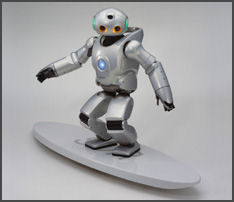
Early December Every Other Year — “International Robot Exhibition” in Tokyo is the world’s largest exhibition focused of robotics. The 2005 event featured robots from 152 countries and 40 organizations. The event was first held in 1973 and is organized by the Japan Robot Association and Nikkan Kogyo Shimbun (a newspaper). In 2007, it featured robots made by 199 companies and 66 organizations and included humanoid and manufacturing robots.
DECEMBER
December 14th — “Gisha-sai at Sengaku-ji Temple” in Tokyo commemorated the deaths of 47 masterless samurai with a parade and other events.
December 15th-18th — “On-Matsuri of Kasuga Shrine” in Nara features a procession of people in Heian period costumes at the Makamiya Shrine, an affiliate of Kasuga Taisha grand shrine, Designated as a national intangible folk cultural property the festival is believed to have been started in 1136 by regent Fujiwara no Tadamuchi (1097-1164) to pray for a good harvest. The procession covers a three kilometer course.
December 17th-19th — “Hagoita-ichi of Asakusa Kannon Temple” in Tokyo is a Battledore Fair.
December 23rd — “Emperor's Birthday” is celebrated throughout the nation.
Late December — “Comic Mart” in Tokyo. See August
December 31st — “Okera Mairi” is the sacred fire ceremony held at Yasaka Shrine in Kyoto.
Late December — “Luminarie” is light display in Kobe intended to demonstrate the rebirth of the city after the earthquake. The light displays, which uses more than a million lights, are arranged over one of the main shopping streets and in a nearby by park. The display is a big deal and the crowds that come to see it can be suffocating.
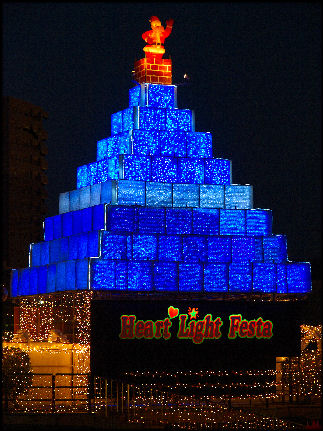
Late December — “Christmas Lights” in the Tokyo Area can be seen in the Marunouchi business district, with 850,000 lights; Ginza, with a 10-meter-tall Christmas tree; Roppongi Hills in the new entertainment district of Minato ward, where blue and white lights are strung on a 400-meter section of road. Lighted trees are set up at Tokyo Tower, Shinjuku Park Tower and Queen’s Square in Yokohama. In Odiaba a statue of Godzillas with 10,000 lights is set next an ornament-covered tree. Lights also illuminate Tokyo Dome City, Yebisu Garden Place, and Takashima Times Square in Tokyo.
Rows of tree with 40,000 LEDs are featured in Tokyo Midtown. The Marunouchi Naka-dori avenue display is on 221 trees between Yurakucho and Otemachi.
Late December — “German Christmas Market” in Osaka featured a 27-meter-high Christmas tree with 100,000 lights and market featuring German-style Christmas items and foods. It is held in the first floor of the Umeda Sky Building in Kita ward, Osaka.
Late December — “Christmas Light Displays” light up the main street in Nagoya, Kyoto, Sendai, Sapporo and Hiroshima. The 1.2 million lights in Hiroshima are set up on a two-kilometer section of Heiwa Odori boulevard. The display in Nagoya features more than a 100,000 lights on 270 trees. The display in Sapporo has 375,000 lights and laser beams set up on a a 1.4-kilometer-long stretch of road. The one in Sendai has 700,000 lights on 220 trees. The one in Hiroshima features 900,000 lights on various monuments and fairy-tale characters, a castle and a train.
Image Sources: 1) Andrew Gray Photosensibility 2) 4) 5) 7) 9) 10) 11) 12) JNTO 3) Association for the Promotion of Traditional Crafts Industries 6) Japan Visitors 8) Jun of Goods from Japan 13) 20) Ray Kinnane 14) Sado island Tourism 15) xorsyst blog 16) Hector Garcia 17) 19) Sony 18) Nara City
Text Sources: New York Times, Washington Post, Los Angeles Times, Daily Yomiuri, Times of London, Japan National Tourist Organization (JNTO), National Geographic, The New Yorker, Time, Newsweek, Reuters, AP, Lonely Planet Guides, Compton’s Encyclopedia and various books and other publications.
